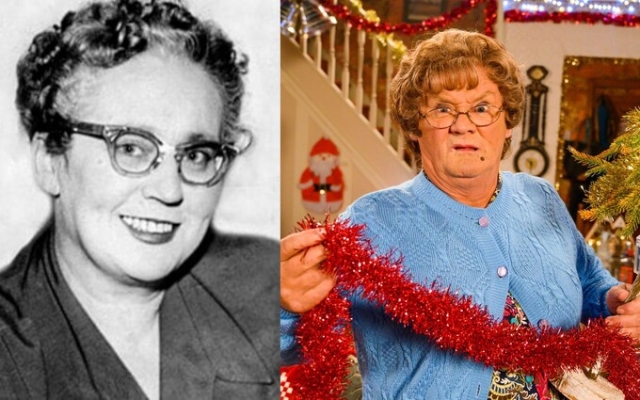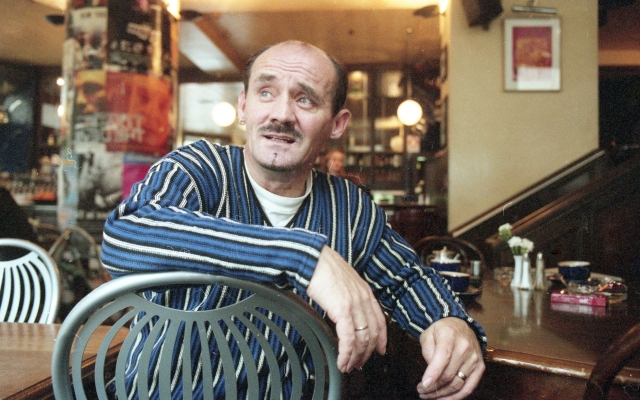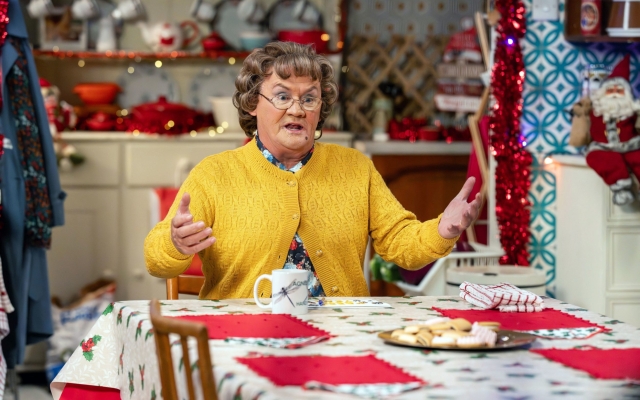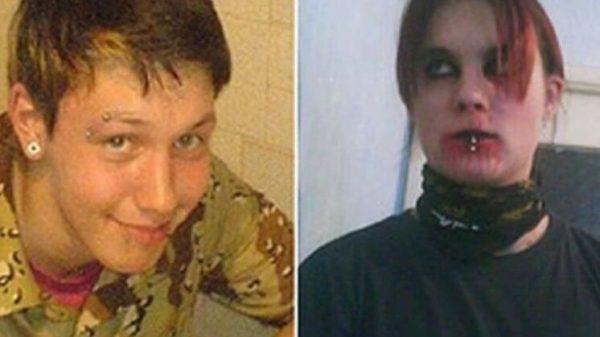 Maureen O'Carroll (left) and her son Brendan as Agnes Brown Photo: Alan Peebles
Maureen O'Carroll (left) and her son Brendan as Agnes Brown Photo: Alan Peebles
Brendan O'Carroll's bumbling Irish mum, Agnes Brown, made the Dublin comedian famous and rich — and widely hated by comedy purists/snobs (delete depending on point of view). This festive period, as fans eagerly await the new Christmas special of Mrs Brown's Boys — and the rest of the world trembles in horror — O'Carroll may well be thinking about his own mother Maureen. After all, Christmas is a time to look back and reflect on those who shaped us. And few in childhood had a figure as large as in real life as Maureen O'Carroll did in the figure of her son.
Her story could be a special Christmas event in itself. It's not a comedy, although she had the same wit as Brendan. The Life and Times of Maureen O'Carroll would work best as a straight drama. It's all there: war, politics, religion, social justice, pioneering feminism — plus an escaped nun turned poverty fighter. Along the way, she found time to raise 11 children in difficult economic conditions. This is an extraordinary story about a woman who deserves more than just a footnote in a Marmite comic biography.
An apron-wearing dervish, Maureen O'Carroll was one of the most innovative politicians of her time. In Ireland, she broke the political glass ceiling, which at the time was reinforced by concrete. In the fifties she represented the Labor Party, co-founded by the socialist revolutionary James Connolly, in the House of Representatives, being elected on her first attempt to represent the (now defunct) Dublin North Central constituency.
Ireland had no shortage of women rebels — from the noble Countess Markievicz to the socialist activist Rosie Hackett, the chalk and cheese arsonists who fought together during the Easter Rising. However, in the gray, dark years after World War II, women politicians were rare.

O'Carroll was one of five people elected to the lower house of Parliament in the 1954 general election. There she immediately laid a trail. She is credited with bringing about social change in a country mired in post-war austerity, and where the Catholic Church believed itself to be more powerful than the government (a view shared by many in the government).
«She didn't take shit.» — her famous son will say later. “She was as sharp as a razor blade.”
Little Mo, as Maureen was known to political friends and foes, is remembered as a force of nature. «All who knew her spoke of her remarkable presence, and the adjectives continued to be heard as people tried to define the extraordinary reserves of energy she possessed,» wrote local historian Mary J. Murphy, paying tribute to O'Carroll for her almu. mater, Galway University.
“Life force. Inspiration. Energy, drive and determination,” Murphy continued. “The impudence and sheer irresistibility hidden in her modest little body were obvious to all as her hallmarks.”
Brendan O’Carroll makes a big deal about Agnes Brown being a native of Dublin. Ironically, Maureen's story began on the opposite side of Ireland, in Mayo, where she studied at Jesus and Mary College Crossmolina.
 Brendan O'Carroll, 1998. Photo: Getty
Brendan O'Carroll, 1998. Photo: Getty
Her father, Michael, was a journalist and revolutionary. He wrote for the Tuam Herald and Freeman's Journal. He also fought in the Easter Rising and worked as an operative for IRA intelligence chief Michael Collins. Maureen, for her part, trained as a novice nun in the Order of Jesus and Mary and received a degree in English from University College Galway, as it was then. She then abandoned her vow to become a teacher.
“My mom was very sweet,” Brendan O’Carroll said in the radio documentary. “It was a very radical thing to do at the time. The only worse thing about the thirties than not having a child go into the priesthood or a monastery was having a child go in and then out again.»
By the 1950s, she had married carpenter Gerard O. “Carroll lived in Finglas, a new working-class suburb in north Dublin. However, few people were interested in home life. She plunged into left-wing politics, leading a campaign against post-war profiteering.
«Maureen was very active in what was called the Price Cut Council,» says Dublin social historian Donal Fallon, host of the Three's Burning Castles podcast.
“This was a tradition of political activism in working-class Dublin, particularly among working-class women. In the new suburbs, women participated in campaigns against high prices in stores that had a monopoly on the new areas. Inflation during war is a serious problem,” Fallon explains. “In a country that was not even involved in the war, we lived for a long time in conditions of shortages, rationing and other consequences of the war. It is interesting to compare the Irish and British experiences of the post-war period. In Britain there is the Nye-Bevan movement for the creation of the National Health Service and large-scale housing construction. In Ireland we introduced bread rationing in January 1947.»
 Brendan O'Carroll as Agnes Brown in this film This year's Mrs Brown's Boys Christmas Special Photo: Elaine Livingstone/BBC
Brendan O'Carroll as Agnes Brown in this film This year's Mrs Brown's Boys Christmas Special Photo: Elaine Livingstone/BBC
Maureen became a leading voice on the Price Reduction Council. One newspaper joked that its motto could be «LPC, C'est Mois.» She was also clearly destined for great things. And so it turned out: in 1954, Little Mo was elected to the House of Representatives from the Labor Party. Labor set about forming a new government as a junior coalition partner of Fine Gael and several smaller parties, with O'Carroll appointed as its chief whip.
“She was more than just a parliamentarian. She was the chief whip of the Labor Party. This was very important. She was the first woman to hold that office in any political party,” Fallon says. “It sounds strange to us now, but the leader of the Labor Party in the fifties, William Norton, was a member of the Knights of St Columbanus [a Catholic brotherhood] and was adamant that the views of the Labor Party in Ireland could be in harmony with papal encyclicals. It was a much more conservative society, even among the Social Democrats.”
Passionate and quick, she was the Labor Party's not-so-secret weapon. «It says a lot about it that Labor used it all over the country at election rallies for other candidates in 1956,» says Fallon. “She said at one meeting in Cork that “prices will be controlled and allowed to rise only when the workers are assured of a corresponding increase in wages, and the old, the sick, widows, orphans and the unemployed are compensated for any unavoidable costs.” the supply of essential goods is increasing.»
 Brendan O'Carroll and his co-stars at the 2020 National Television Awards . Photo: WireImage
Brendan O'Carroll and his co-stars at the 2020 National Television Awards . Photo: WireImage
A firebrand in the House of Parliament and on the streets, she introduced several historic reforms. Until the mid-fifties, Ireland's national police force, the Garda, consisted entirely of men. O'Carroll successfully advocated for women officers, then known as «Ban Garda» or «women guards». She was also involved in removing the status of «illegitimacy» from laws.
«What she was saying was not very popular,» Labor historian Niamh Puirsay said in the documentary The Real Mrs Brown ( 2018). “It was a very courageous society. [Many things] would not be on the agenda of male parliamentarians.”
Her political career inevitably ended in relative failure. By the end of the fifties, the Fine Gael-Labor administration had become unpopular. O'Carroll was one of many state TDs to lose their seats in 1957. She returned to raising her children, including Brendan. He grew up with her office wit and belief that hard work could overcome any obstacle — lessons he learned carefully as his comedy career blossomed and he fought his way to a net worth of an estimated £10 million.
She was also a direct inspiration for the salty, no-nonsense Agnes Brown, and was widely mourned when she died in 1984 at the age of 71. «The legacy she left me,» Brendan said, «is that every time I sit down to write to Mrs. Brown, I hear her voice.»
Mrs. Brown's Boys Special, consisting of two-parter, airs on BBC1 at 10.45pm on Christmas Day and 10pm on New Year's Day


























































Свежие комментарии